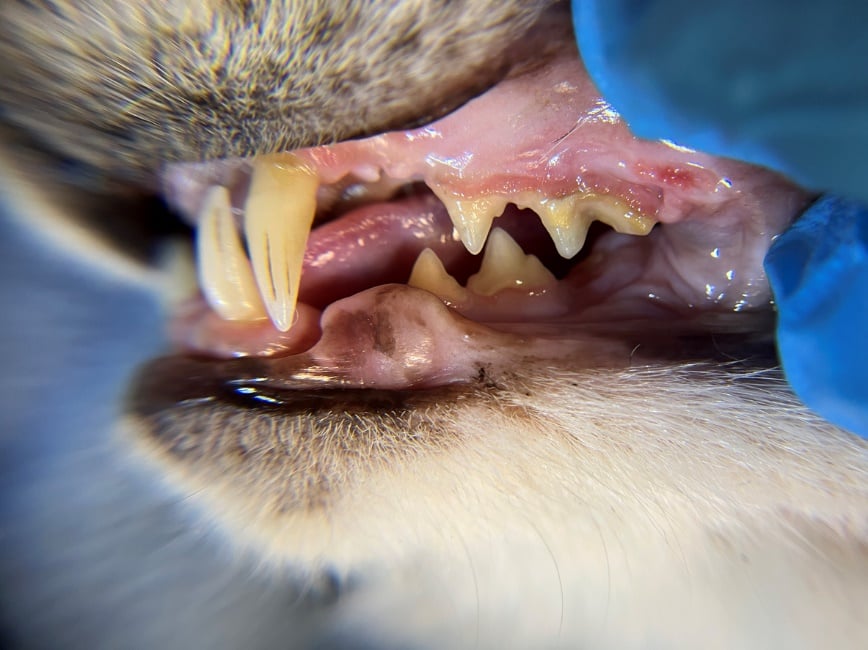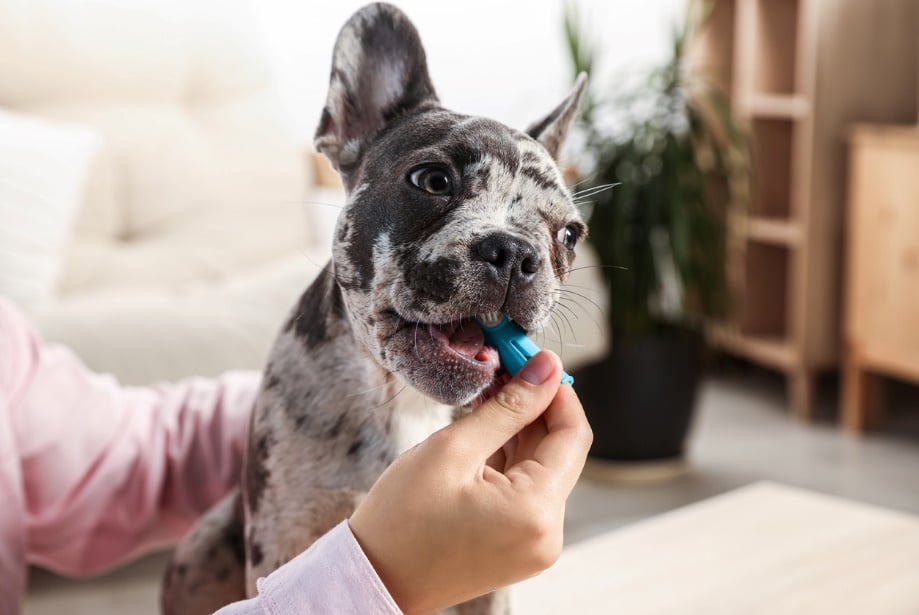Did you know that pets can suffer from dental issues just like humans? While their wagging tails and joyful purrs might mask discomfort, oral health problems are surprisingly common and often overlooked. February, National Pet Dental Health Month, is the perfect time to learn how proper dental care for pets can lead to happier, healthier lives—and fewer vet visits for painful dental procedures!
At Advanced Pet Care Clinic, we are here to make pet dental health simple and effective, so your furry friends can continue enjoying their favorite treats, toys, and your love and care.
How We Assess Your Pet's Dental Health

Level 3:Picture of an anesthetized cat with tartar, periodontal disease, gingivitis, and oral cancer
Our approach to dental care for pets starts with understanding their specific needs. At Advanced Pet Care Clinic, we use a three-level dental scale to guide our treatment recommendations:
- Level 1: Mild tartar and plaque buildup. This level requires a routine descaling, similar to a human cleaning.
- Level 2: Moderate tartar and gum inflammation (gingivitis), requires dental cleaning and may require antibiotics.
- Level 3: Advanced plaque buildup, severe gum disease, and potential tooth loss can lead to significant pain and discomfort. Treatment may involve deep cleaning to remove plaque and tartar from the teeth and below the gumline, gum disease management with antibiotics or antimicrobials, and, if necessary, tooth extractions to relieve pain and prevent further damage.
These levels help us tailor care, ensuring your pet receives the professional care they need to maintain a healthy, pain-free smile.
Seeing Dental Care for Pets in a New Light
For those who have not considered dental care for pets, it is natural to wonder if it is necessary. While it may not have been customary practice years ago, we now have the knowledge and tools to give pets a higher quality of care.
If you have ever caught a whiff of your pet’s bad breath, you might have brushed it off as "normal." But did you know that over 80% of pets over three years old have dental disease to one degree or another? This silent condition can lead to:
- Chronic pain and difficulty eating
- Bad breath (halitosis)
- Infections that spread to other parts of the body
- Reduced lifespan due to systemic health problems
By prioritizing dental care for pets, you are improving their oral health and investing in their overall well-being and longevity.
Making Dental Care at Home Manageable

Brushing your pet’s teeth might seem like an impossible task, but with patience and the right tools, it can become a regular part of their routine. Here is how to make it easier:
Use Toothbrushes and Toothpaste Made for Pets
There are many types of toothbrushes and finger brushes for pets. Ask us which one might suit your pet best.
Never use toothpaste for humans on pets because it contains harmful ingredients like xylitol, which is toxic to pets, especially dogs. It also has high levels of fluoride that can upset their stomachs, and foaming agents that may cause nausea or vomiting. Pets swallow toothpaste during brushing, so these ingredients can lead to serious health issues.
Pet enzymatic toothpastes help keep your pet’s teeth clean by breaking down plaque and fighting bacteria that cause bad breath and gum disease. The special enzymes in the toothpaste work with your pet’s saliva to clean their mouth without needing to rinse. Safe and tasty with flavors like poultry, beef, and seafood, they make brushing your pet’s teeth easier and effective.
Start Simple and Slowly
- Let your pet lick pet-safe toothpaste off your finger before introducing a brush. You can experiment with flavors to see which one your pet likes best.
- When your pet is familiar with the toothpaste, you can rub a little bit of the toothpaste on your pet’s lips, gums, and teeth.
- Do these steps for as many days as necessary until you see that your pet is comfortable with the toothpaste.
- Once your pet accepts the toothpaste, add the toothpaste to a pet toothbrush or finger brush and let them lick off while they become familiar with the toothbrush.
- When your pet is familiar with the toothbrush, start brushing slowly and a bit at a time. You can gradually work up to a longer and more thorough brushing.
Throughout each step, reward your pet with treats and praise so they associate teeth brushing as a pleasurable experience.
For a step-by-step guide and visual tips on brushing your pet's teeth, the article from the American Veterinary Medical Association (AVMA) includes a helpful video in their article: Pet Dental Care.
Alternatives to brushing
If brushing is not practical with your pet, do not worry—alternatives like Sanos Sealant can protect your pet’s gumline for up to six months. This innovative solution offers a stress-free way to maintain oral health between cleanings. Sanos acts like a liquid bandage, sealing the gum line and protecting against plaque formation. It is especially beneficial if your pet has gingivitis, as it helps prevent future infections.
Join Our Friday Smile Club!
Ready to take the first step toward better dental care for pets? Schedule a dental cleaning on a Friday and join our Friday Smile Club to receive 10% off your pet’s dental treatment. Your furry friend will thank you with wagging tails, happy purrs, and, of course, a healthier smile!
This February let us make dental health a priority for your pet. Call us today or visit Advanced Pet Care Clinic to learn more about our Friday Smile Club and Specials and schedule a dental cleaning. Together, we will ensure your pet stays happy, healthy, and pain-free for years to come.
Advanced Pet Care Clinic
4507 Algonquin Drive, Suite A
Cedar Falls, IA 50613
(319) 220-5926
[email protected]

